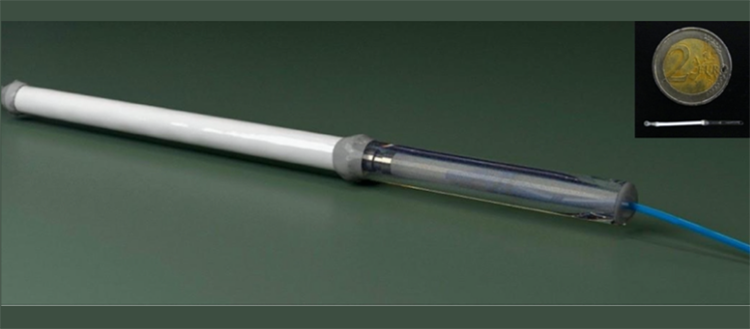Cell encapsulation could enhance antiviral vaccines
A team from the UNIGE and the HUG has developed a new and effective anti-viral vaccination technique based on the cell encapsulation.

The cargo capsule can contain up to one million protein-secreting cells (adjuvant, antibody or other). Placed under the skin, it allows the cells it contains to be nourished by the body and to be active until the implant is removed several days after vaccination. ©UNIGE/HUG/MaxiVAX
Immunotherapy techniques developed in oncology to combat cancerous cells have great potential for fighting viruses. A research team from the University Hospitals of Geneva (HUG) and the University of Geneva (UNIGE), in Switzerland, in collaboration with MaxiVAX, a spinoff of both institutions, developed an innovative technology called "cell encapsulation". Originally designed to stimulate immunity to fight cancer, the COVID-19 pandemic motivated the scientists to broaden the scope of their technology to test its effectiveness against viruses. The first results of a pre-clinical study are very encouraging and can be discovered in the journal Vaccines.
The immune system is able to identify cancer cells and fight them, just as it does against a viral or bacterial pathogen. Researchers therefore rely on this to develop vaccines against cancer. "To develop an effective vaccine, two elements are needed: a target recognized by the immune system, such as cells, proteins, DNA or RNA sequences, and an adjuvant able to effectively stimulate the immune response", says Nicolas Mach, an oncologist at the HUG Division of Oncology, and a professor at UNIGE Faculty of Medicine Department of Medicine and Translational Research Centre in Onco-Haematology, and co-author of this study. To this end, Nicolas Mach and his team, in partnership with the company MaxiVAX, developed a novel cell-based cancer vaccination using cell encapsulation technology. With the coronavirus pandemic and the need to develop effective vaccines, they decided to extend the scope of this technology to test its effectiveness against viruses.
Exciting the immune system over the long term
Cell encapsulation consists of filling a semipermeable capsule with engineered cells before implanting it subcutaneously. The cells contained in the capsule are thus kept alive without spreading in the body, unlike their secretion, which is free to diffuse through the capsule wall. This technology therefore allows the stable and sustained long-term production and release of proteins such as cytokines or antibodies.
Loaded with cells modified to secrete a substance capable of stimulating the immune system, the capsule can be used as an adjuvant cargo ship. Since the encapsulated cells survive for days, weeks or even months, they allow for prolonged exposure to the substance they secrete, here the vaccine adjuvant. This is an undeniable advantage compared to standard vaccination strategies that cannot achieve such goal.
Coronavirus as proof of concept
For this study led on mice, the research team first vaccinated healthy mice against SARS-COV-2 by injecting them with the gene coding for the Spike viral protein, which is one of the small parts of the virus recognised by the immune system. Since only a small fraction of the virus is injected, the virus, lacking its machinery, is unable to infect the body and cause COVID-19.
To efficiently boost the immune system, the scientists used the tool they developed over the last two years, a genetically modified muscle cell line secreting GM-CSF, a protein known to promote the growth of white blood cells and able, under certain conditions, to train very effectively the immune system to react against a pathogenic target. "GM-CSF is like a hormone for the white blood cells, which are just as useful for defeating tumours as they are for defeating pathogens," explains the oncologist.
In order to use GM-CSF as an adjuvant to enhance the immune response against the SARS-CoV-2 Spike target, the lab-produced cells are encapsulated. The capsule, introduced subcutaneously close to the vaccination site, remains in place for several days before being removed.
Treated mice developed antibodies and lymphocytes against SARS-CoV2. The study shows that their immune response was stronger when using the encapsulation technique to produce the booster protein GM-CSF over several days than when GM-CSF was injected directly with the target. "Our results show that our cell encapsulation approach significantly enhances the excitatory effect of GM-CSF ", Nicolas Mach is pleased to say. Furthermore, when used without any GM-CSF adjuvant, the vaccine triggered an even weaker immune response.
An innovative avenue to fight vaccine-resistant viruses
"In view of the remarkable efficacy of mRNA vaccines against coronavirus, we do not consider it useful to develop clinical trials in humans for this use. However, if the efficacy of this vaccination technology is confirmed in other models of viral diseases, it could be used to fight pathogens against which we are currently lacking efficient vaccines, such as HIV or hepatitis C virus," concludes Nicolas Mach.
The capsules and the cells used in this study are certified for Phase I and II clinical trials in oncology and are produced by the HUG's clinical cell therapy centre.
